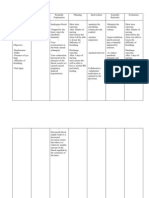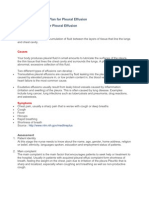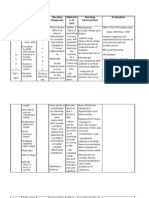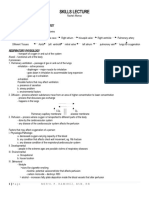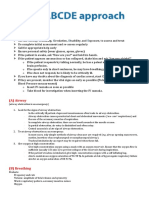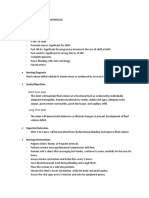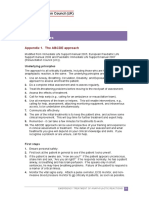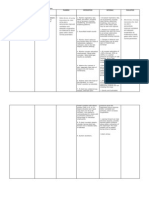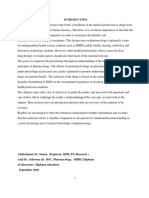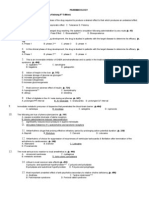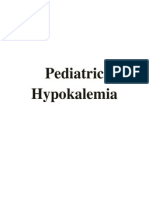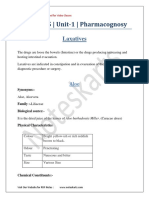Assessment Diagnosis Planning Implementation Rationale Evaluation
Assessment Diagnosis Planning Implementation Rationale Evaluation
Uploaded by
Jennifer ArdeCopyright:
Available Formats
Assessment Diagnosis Planning Implementation Rationale Evaluation
Assessment Diagnosis Planning Implementation Rationale Evaluation
Uploaded by
Jennifer ArdeOriginal Title
Copyright
Available Formats
Share this document
Did you find this document useful?
Is this content inappropriate?
Copyright:
Available Formats
Assessment Diagnosis Planning Implementation Rationale Evaluation
Assessment Diagnosis Planning Implementation Rationale Evaluation
Uploaded by
Jennifer ArdeCopyright:
Available Formats
Assessment Subjective: Namamaga ang ibang parte ng katawan ko. As verbalized by the client.
Objective: - Intake greater than output - Weight gain - Edema - 140/100mmHg - 103 bpm
Diagnosis Fluid Volume Excess related to compromised regulatory mechanism as evidenced by intake greater than output; edema; weight gain and as verbalized by the client namamaga ang ibang parte ng katawan ko.
Planning Within the 3 days of nursing intervention the client will be able to decrease weight; edema and normalized intake and output and a verbalization of Hindi n masyadong namamaga itong katawan ko.
Implementation Independent: - Record accurate intake and output (I&O). Include hidden fluids such as IV antibiotic additives, liquid medications, ice chips, frozen treats. Measure gastrointestinal (GI) losses and estimate insensible losses, e.g., diaphoresis.
Rationale -Low output (less than 400 mL/24 hr) may be first indicator of acute failure, especially in a high-risk patient. Accurate I&O is necessary for determining renal function and fluid replacement needs and reducing risk of fluid overload. Note:Hypervolemia occurs in the anuric phase of ARF. -Daily body weight is best monitor of fluid status. A weight gain of more than 0.5 kg/day suggests fluid retention. -Edema occurs primarily in dependent tissues of the body, e.g., hands, feet, lumbosacral area.
Evaluation After 3 days of nursing intervention the client was able to decrease weight; edema and normalized intake and output and a verbalization of Hindi n masyadong namamaga itong katawan ko. And the goal was met.
-Weigh daily at same time of day, on same scale, with same equipment and clothing. -Assess skin, face, dependent areas for edema. Evaluate degree of edema (on scale of +1+4).
Patient can gain up to 10 lb (4.5 kg) of fluid before pitting edema is detected. Periorbital edema may be a presenting sign of this fluid shift because these fragile tissues are easily distended by even minimal fluid accumulation -Monitor heart rate (HR), BP, and JVD/CVP. -Tachycardia and hypertension can occur because of (1) failure of the kidneys to excrete urine, (2) excessive fluid resuscitation during efforts to treat hypovolemia/hypotension or convert oliguric phase of renal failure, and/or (3) changes in the reninangiotensin system. Note: Invasive monitoring may be needed for assessing intravascular volume, especially in patients with
poor cardiac function. -Auscultate lung and heart sounds. -Fluid overload may lead to pulmonary edema and HF evidenced by development of adventitious breath sounds, extra heart sounds. (Refer to ND: Cardiac Output, risk for decreased, following.) -May reflect fluid shifts, accumulation of toxins, acidosis, electrolyte imbalances, or developing hypoxia. -Helps avoid periods without fluids, minimizes boredom of limited choices, and reduces sense of deprivation and thirst
-Assess level of consciousness; investigate changes in mentation, presence of restlessness. -Plan oral fluid replacement with patient, within multiple restrictions. Intersperse desired beverages throughout 24 hr. Vary offerings, e.g., hot, cold, frozen.
Dependent: -Administer Drugs (e.g. Furosemide) as prescribed.
- Given early in oliguric phase of ARF in an effort to convert to non-oliguric phase, flush the tubular lumen of debris, reduce hyperkalemia, and promote adequate urine volume. -Kidneys may be able to return to normal functioning, preventing or limiting residual effects.
Collaborative: -Correct any reversible cause of ARF, e.g., replace blood loss, maximize cardiac output, discontinue nephrotoxic drug, relieve obstruction via surgery.
Assessment Subjective: Parang Bumibilis ang pagtibok ng puso ko.. As verbalized by the client. Objective: - 103 bpm - 140/100mmHg - Edema
Diagnosis Decreased cardiac output related to fluid overload as evidenced by tachycardia with a heart rate of 103 bpm and as verbalized by the patient parang bumibilis ang pagtibok ng puso ko.
Planning Implementation Within 30 minutes of Independent: nursing intervention - Monitor BP and HR. the client will be able to decreased heart rate within the normal range and will verbalized Hindi n mabilia ang pagtiok ng puso ko.
Rationale - Fluid volume excess, combined with hypertension (often occurs in renal failure) and effects of uremia, increases cardiac workload and can lead to cardiac failure. In ARF, cardiac failure is usually reversible. - Changes in electromechanical function may become evident in response to progressing renal failure/accumulation of toxins and electrolyte imbalance. For example, hyperkalemia is associated with peaked T wave, wide QRS, prolonged PR interval, flattened/absent P wave. Hypokalemia is associated with flat T wave, peaked P wave, and
Evaluation After 30 minutes of nursing intervention the client was able to decreased heart rate within the normal range and has verbalized Hindi n mabilia ang pagtiok ng puso ko. And the goal was partially met.
-Observe ECG or telemetry for changes in rhythm
appearance of U waves. Prolonged QT interval may reflect calcium deficit. - Auscultate heart sounds. -Development of S3/S4 is indicative of failure. Pericardial friction rub may be only manifestation of uremic pericarditis, requiring prompt intervention/possibly acute dialysis. - Pallor may reflect vasoconstriction or anemia. Cyanosis is a late sign and is related to pulmonary congestion and/or cardiac failure. - Neuromuscular indicators of hypocalcemia, which can also affect cardiac contractility and function.
-Assess color of skin, mucous membranes, and nailbeds. Note capillary refill time.
-Investigate reports of muscle cramps, numbness/tingling of fingers, with muscle twitching, hyperreflexia.
- Maintain bedrest or encourage adequate rest and provide assistance with care and desired activities. Dependent: - Administer medications as indicated: Inotropic agents, e.g., digoxin (Lanoxin);
- Reduces oxygen consumption/cardiac workload.
- May be used to improve cardiac output by increasing myocardial contractility and stroke volume. Dosage depends on renal function and potassium balance to obtain therapeutic effect without toxicity. - During oliguric phase, hyperkalemia is present but often shifts to hypokalemia in diuretic or recovery phase. Any potassium value associated with ECG changes requires intervention. Note: A serum level of 6.5 mEq or higher constitutes a medical emergency.
Collaborative: - Monitor laboratory studies (e.g. Potassium, etc.)
Assessment Subjective: Medyo nahihirapan akong huminga. As verbalized by the client. Objective: - Cyanosis - 35cpm
Diagnosis Ineffective airway clearance related to inhalation of chemicals as evidenced by tracheobronchial obstruction; cyanosis; respiratopry rate of 35cpm and a verbalization of Medyo nahihirapan akong huminga.
Planning Within 30 minutes of nursing intervention the client will have no obstruction; no cyanosis; respiratory rate within the normal range and a verbalization of hindi na ako nahihirapang huminga.
Implementation Independent: - Obtain history of injury. Note presence of preexisting respiratory conditions, history of smoking.
Rationale - Causative burning agent, duration of exposure, and occurrence in closed or open space predict probability of inhalation injury. Type of material burned (wood, plastic, wool, and so forth) suggests type of toxic gas exposure. Preexisting conditions increase the risk of respiratory complications.
Evaluation Within 30 minutes of nursing intervention the client has no obstruction; no cyanosis; respiratory rate within the normal range and a verbalization of hindi na ako nahihirapang huminga. And the goal was
- Assess gag/swallow - Suggestive of reflexes; note drooling, inhalation injury. inability to swallow, hoarseness, wheezy cough. - Monitor respiratory rate, rhythm, depth; note presence of pallor/cyanosis and carbonaceous or pinktinged sputum. - Tachypnea, use of accessory muscles, presence of cyanosis, and changes in sputum suggest developing respiratory distress/pulmonary
edema and need for medical intervention. - Investigate changes in behavior/mentation, e.g., restlessness, agitation, confusion. - Although often related to pain, changes in consciousness may reflect developing/worsening hypoxia. - Promotes optimal lung expansion/respiratory function. When head/neck burns are present, a pillow can inhibit respiration, cause necrosis of burned ear cartilage, and promote neck contractures - Promotes lung expansion, mobilization and drainage of secretions.
- Elevate head of bed. Avoid use of pillow under head, as indicated.
- Encourage coughing/deepbreathing exercises and frequent position changes.
-Suction (if necessary) with extreme care, maintaining sterile technique.
- Helps maintain clear airway, but should be done cautiously because of mucosal edema and inflammation. Sterile technique reduces risk of infection. - Increasing hoarseness/decreased ability to swallow suggests increasing tracheal edema and may indicate need for prompt intubation. - O2 corrects hypoxemia/acidosis. Humidity decreases drying of respiratory tract and reduces viscosity of sputum.
-Promote voice rest, but assess ability to speak and/or swallow oral secretions periodically.
Dependent: - Administer humidified oxygen via appropriate mode, e.g.,face mask as ordered.
Collaborative: - Prepare for/assist with intubation or tracheostomy, as indicated.
-Intubation/mechanical support is required when airway edema or
circumferential burn injury interferes with respiratory function/oxygenation.
Assessment Subjective: Nauuhaw ako sobra sobra. As verbalized by the client. Objective: - Cyanosis - 35cpm
Diagnosis Fluid Volume deficit related to burns as evidenced by general burn wounds; thrist; dry mucous membranes and a verbalization of Nauuhaw ako sobra sobra.
Planning Within 30 minutes of nursing interventions the client will be able to have moist mucous membranes; no thrist and a verbalization of Hindi n ako nauuhaw kagaya ng dati.
Implementation Independent: - Estimate wound drainage and insensible losses
Rationale - Increased capillary permeability, protein shifts, inflammatory process, and evaporative losses greatly affect circulating volume and urinary output, especially during initial 2472 hr after burn injury. - Massive/rapid replacement with different types of fluids and fluctuations in rate of administration require close tabulation to prevent constituent imbalances or fluid overload. - May be helpful in estimating extent of edema/fluid shifts affecting circulating volume and urinary output.
Evaluation Within 30 minutes of nursing interventions the client was able to have moist mucous membranes; no thrist and a verbalization of Hindi n ako nauuhaw kagaya ng dati. And the goal was partially met.
- Maintain cumulative record of amount and types of fluid intake.
- Measure circumference of burned extremities as indicated.
Dependnet: - Administer calculated IV replacement of fluids, electrolytes, plasma, albumin as prescribed.
- Fluid resuscitation replaces lost fluids/electrolytes and helps prevent complications, e.g., shock, acute tubular necrosis (ATN). Replacement formulas vary (e.g., Brooke, Evans, Parkland) but are based on extent of injury, amount of urinary output, and weight. Note: Once initial fluid resuscitation has been accomplished, a steady rate of fluid administration is preferred to boluses, which may increase interstitial fluid shifts and cardiopulmonary congestion. - Allows for close observation of renal function and prevents urinary
Collaborative: -Assist in inserting indwelling urinary catheter.
retention. Retention of urine with its byproducts of tissue-cell destruction can lead to renal dysfunction and infection.
You might also like
- Copd NCPDocument16 pagesCopd NCPSuperMaye100% (1)
- Nursing Care Plan - Pulmonary EmbolismDocument3 pagesNursing Care Plan - Pulmonary EmbolismPui_Yee_Siow_6303100% (10)
- SCIQuestions CaseStudyKeyDocument4 pagesSCIQuestions CaseStudyKeyDeez NutsNo ratings yet
- NCP FORM For TetralogyDocument3 pagesNCP FORM For TetralogyGraceMelendres100% (3)
- Tuberculosis Nursing Care Plan - Ineffective Airway ClearanceDocument2 pagesTuberculosis Nursing Care Plan - Ineffective Airway ClearanceCyrus De Asis86% (36)
- Hypovolemic Shock Case StudyDocument6 pagesHypovolemic Shock Case StudyJenn GallowayNo ratings yet
- Liberation From Mechanical VentilationDocument21 pagesLiberation From Mechanical VentilationRins Chacko50% (2)
- Decreased Cardiac OutputDocument9 pagesDecreased Cardiac OutputChinita Sangbaan75% (4)
- NCP Pleural EffusionDocument7 pagesNCP Pleural EffusionEjie Boy Isaga100% (2)
- PharmacologyDocument13 pagesPharmacologyCARTAGENA1100% (20)
- Ventricular Septal Defect, A Simple Guide To The Condition, Treatment And Related ConditionsFrom EverandVentricular Septal Defect, A Simple Guide To The Condition, Treatment And Related ConditionsNo ratings yet
- COMPREHENSIVE NURSING ACHIEVEMENT TEST (RN): Passbooks Study GuideFrom EverandCOMPREHENSIVE NURSING ACHIEVEMENT TEST (RN): Passbooks Study GuideNo ratings yet
- The Ride of Your Life: What I Learned about God, Love, and Adventure by Teaching My Son to Ride a BikeFrom EverandThe Ride of Your Life: What I Learned about God, Love, and Adventure by Teaching My Son to Ride a BikeRating: 4.5 out of 5 stars4.5/5 (2)
- Cardiac ComplicationDocument12 pagesCardiac ComplicationResa ShotsNo ratings yet
- Risk For AspirationDocument9 pagesRisk For AspirationFerreze AnnNo ratings yet
- Nursing Management of BurnDocument40 pagesNursing Management of BurnSalinKaur0% (1)
- Renal Failure Nursing Care PlanDocument2 pagesRenal Failure Nursing Care Planemman_abz33% (3)
- NCP Eclampsia 1Document2 pagesNCP Eclampsia 1Thesa FedericoNo ratings yet
- NCP-Case Presentation (CHF)Document4 pagesNCP-Case Presentation (CHF)Jessamine EnriquezNo ratings yet
- Nursing Care PlanDocument4 pagesNursing Care PlanAdreanah Martin RañisesNo ratings yet
- NCP IcuDocument12 pagesNCP IcuHazel Palomares50% (2)
- Assessment Diagnosis Rationale Planning Interventions Rationale EvaluationDocument3 pagesAssessment Diagnosis Rationale Planning Interventions Rationale EvaluationJharene BasbañoNo ratings yet
- Mary Cris Canon CHF For or Case Study.Document12 pagesMary Cris Canon CHF For or Case Study.Mary Cris CanonNo ratings yet
- Most Common Nursing Care Plans (1)Document96 pagesMost Common Nursing Care Plans (1)rn.nursetomlinsonNo ratings yet
- Ncp'sDocument8 pagesNcp'sDuchess Kleine RafananNo ratings yet
- Care Plan Designed For Mr. SalmanDocument2 pagesCare Plan Designed For Mr. SalmanHouda HayekNo ratings yet
- LUNGcancer NCPregieDocument1 pageLUNGcancer NCPregieShermay MortelNo ratings yet
- ABCDE Approach, Resus - Org.ukDocument7 pagesABCDE Approach, Resus - Org.ukMohamed NasrAllahNo ratings yet
- NCP PleuralDocument5 pagesNCP Pleuraljanine_valdezNo ratings yet
- Assessment of Cardiovascular SystemDocument5 pagesAssessment of Cardiovascular SystemAnamika ChoudharyNo ratings yet
- Nursing Care PlanDocument28 pagesNursing Care PlanChristine Karen Ang Suarez67% (3)
- Foundations Exam 3Document25 pagesFoundations Exam 3TeNo ratings yet
- NCLEX Day 1Document17 pagesNCLEX Day 1jasonNo ratings yet
- NCP Poststreptococcal GlomerulonephritisDocument12 pagesNCP Poststreptococcal GlomerulonephritisScarlet ScarletNo ratings yet
- Done - Skills LectureDocument31 pagesDone - Skills LectureMeryl RamosNo ratings yet
- Mechanical VentilationDocument42 pagesMechanical VentilationWiz SamNo ratings yet
- The Main Principles:: A B C D EDocument4 pagesThe Main Principles:: A B C D EHatem FaroukNo ratings yet
- NCP'SDocument10 pagesNCP'SEjie Boy IsagaNo ratings yet
- NCPDocument15 pagesNCPCamille PinedaNo ratings yet
- Ineffective Breathing PatternDocument8 pagesIneffective Breathing PatternJansen Arquilita Rivera100% (2)
- Postpartum HemorrhageDocument3 pagesPostpartum HemorrhageClaire Canapi BattadNo ratings yet
- NANDA DefinitionDocument5 pagesNANDA DefinitionAngel_Liboon_388No ratings yet
- Impaired Gas ExchangeDocument4 pagesImpaired Gas ExchangeNuraini Hamzah100% (1)
- Nursing Care Plan FinalDocument16 pagesNursing Care Plan FinalErickson OcialNo ratings yet
- Nursing Care Plan: Hanoi Medical University Advanced Nursing ProgramDocument11 pagesNursing Care Plan: Hanoi Medical University Advanced Nursing Programlephuongloan2601No ratings yet
- A B C D e AssessmentDocument6 pagesA B C D e AssessmentANGELICA JANE FLORENDONo ratings yet
- Nursing Care PlanDocument26 pagesNursing Care PlanPrincessLienMondejarNo ratings yet
- The ABCDE ApproachDocument8 pagesThe ABCDE ApproachAsmaa TahaNo ratings yet
- AH Final Exam Review - FINALDocument19 pagesAH Final Exam Review - FINALRin noharaNo ratings yet
- Elevated Blood PressureDocument3 pagesElevated Blood PressureSean MercadoNo ratings yet
- NCP For Acute Coronary SyndromeDocument3 pagesNCP For Acute Coronary Syndromesarahtot60% (5)
- Interventions For Critically Ill Patients With Respiratory Problems HandoutsDocument115 pagesInterventions For Critically Ill Patients With Respiratory Problems HandoutsDemuel Dee L. BertoNo ratings yet
- Oxy Act 2Document5 pagesOxy Act 2Joshua DauzNo ratings yet
- Abcde Erp39p44Document6 pagesAbcde Erp39p44Elizabeth Toapanta VrnNo ratings yet
- NCP Ineffective Gas ExchangeDocument2 pagesNCP Ineffective Gas ExchangeRez ApegoNo ratings yet
- Nursing DiagnosisDocument16 pagesNursing DiagnosisSi Bunga JonquilleNo ratings yet
- Segui NCPDocument4 pagesSegui NCPRichelle TalaguitNo ratings yet
- عناية م 4Document85 pagesعناية م 4tbtv5wnm9jNo ratings yet
- NCPDocument9 pagesNCPTracy Camille EscobarNo ratings yet
- Nursing Diagnosis Analysis Goal & Objectives Nursing Intervention Rationale EvaluationDocument2 pagesNursing Diagnosis Analysis Goal & Objectives Nursing Intervention Rationale EvaluationLP BenozaNo ratings yet
- Approach To An Unconscious Patient-OyeyemiDocument41 pagesApproach To An Unconscious Patient-OyeyemiOyeyemi AdeyanjuNo ratings yet
- Assessment Diagnosis Planning Implementation Rationale EvaluationDocument14 pagesAssessment Diagnosis Planning Implementation Rationale EvaluationJennifer ArdeNo ratings yet
- AssessmentDocument1 pageAssessmentJennifer ArdeNo ratings yet
- Y Cy Y !"#$Y %!"#$Y & &' (Y + (,YYDocument5 pagesY Cy Y !"#$Y %!"#$Y & &' (Y + (,YYJennifer ArdeNo ratings yet
- NURSING CARE PLAN - SuicidalactDocument4 pagesNURSING CARE PLAN - SuicidalactJennifer ArdeNo ratings yet
- Pathophysiology of ThrombophlebitisDocument3 pagesPathophysiology of ThrombophlebitisJennifer ArdeNo ratings yet
- AdverbDocument1 pageAdverbJennifer ArdeNo ratings yet
- A04 PDFDocument16 pagesA04 PDFQueen JazNo ratings yet
- Congestive Heart Failure: Dr. J. SaravananDocument31 pagesCongestive Heart Failure: Dr. J. Saravananpetervazhayil100% (1)
- Spots 2Document17 pagesSpots 2ashok kalyaniNo ratings yet
- Sdi 2011Document311 pagesSdi 2011Mohammed Ahmad Al-MuhurNo ratings yet
- DIGOXINDocument19 pagesDIGOXINDedeSumantraNo ratings yet
- Intravenous Antibiotics Diagnostic Tests Urinalysis Sputum CultureDocument18 pagesIntravenous Antibiotics Diagnostic Tests Urinalysis Sputum CultureJennifer ChuaNo ratings yet
- Pharmacology Notes NursingDocument25 pagesPharmacology Notes NursingKyle Marks100% (6)
- PharmacologyDocument88 pagesPharmacologyالدنيا ساعة فاجعلها طاعة100% (2)
- Cardiac Surgery - Postoperative ArrhythmiasDocument9 pagesCardiac Surgery - Postoperative ArrhythmiaswanariaNo ratings yet
- NCLEX Select All That Apply Practice Exam 4Document8 pagesNCLEX Select All That Apply Practice Exam 4Heather ClemonsNo ratings yet
- Pharma La La La LaDocument32 pagesPharma La La La LaAndie AlbinoNo ratings yet
- Hypokalemia ReportDocument9 pagesHypokalemia Reportarah006No ratings yet
- SET-J RespReviewResults 20231017 155722Document14 pagesSET-J RespReviewResults 20231017 155722Erika Jane PurificacionNo ratings yet
- Cardiovascular Pharmacology ConceptsDocument11 pagesCardiovascular Pharmacology ConceptsHuney Kumar100% (1)
- Cardiac PoisonsDocument36 pagesCardiac PoisonsTARIQNo ratings yet
- Compilation of QuizzesDocument10 pagesCompilation of QuizzesElesis samaNo ratings yet
- Chapter-5 - Unit-1 - Pharmacognosy: LaxativesDocument9 pagesChapter-5 - Unit-1 - Pharmacognosy: LaxativesAaQib Ali RaZaNo ratings yet
- Pharma Moments: Antianxiety/Sedatives Minor TranquilizersDocument3 pagesPharma Moments: Antianxiety/Sedatives Minor TranquilizersTita MonzalesNo ratings yet
- Congestive Heart Failure ReportDocument6 pagesCongestive Heart Failure ReportSunshine_Bacla_4275100% (1)
- Pharmacology Exam 4 ReviewDocument8 pagesPharmacology Exam 4 ReviewAnonymous 0Yvbef1xNo ratings yet
- 715 PrometricDocument61 pages715 PrometricNosheen HaqNo ratings yet
- Usp DizolvareDocument168 pagesUsp Dizolvaremelania.irimiaNo ratings yet
- Drugs in CHFDocument48 pagesDrugs in CHFBishnu BhandariNo ratings yet
- Respiratory and Cardiovascular Drugs TestDocument10 pagesRespiratory and Cardiovascular Drugs TestMaria Chrislyn Marcos GenorgaNo ratings yet
- Drug InteractionsDocument33 pagesDrug Interactions88AKK100% (1)
- 12 Drugs Acting On The Cardiovascular SystemDocument7 pages12 Drugs Acting On The Cardiovascular SystemJAN CAMILLE LENONNo ratings yet
- 2.20140209 Question PaperDocument16 pages2.20140209 Question PaperdrpnnreddyNo ratings yet
- Domingo, Precious Mae TDocument56 pagesDomingo, Precious Mae Tbevzie datuNo ratings yet
- Board Exam Nursing Test III NLE With AnswersDocument12 pagesBoard Exam Nursing Test III NLE With AnswersRaymark Morales100% (2)

















